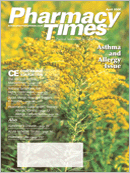Publication
Article
Pharmacy Times
"Comfort" Medications
Author(s):
One of our clinical scholars hasbeen collecting data to assessthe effectiveness of reconcilingmedication orders as patients are dischargedfrom the University of NorthCarolina Hospitals. When the studentand I were reviewing the records of ourfirst 50 patients, I was surprised by thenumber of medication orders for "asneeded" medications that were not continued(no prescriptions written) afterdischarge.
As a young pharmacist, I can rememberprocessing orders for new admissionsto a surgery floor. All had a laxative,a stool softener, a sleep medication,an anxiety medication, and skin lotion asPRN orders. I was told that these routineorders were written "so we can minimizedelays in administering medicationsand make patientsas comfortable as possiblein an unfamiliarenvironment." On thesurface, it makes sense,but, as my student andI reviewed patients' ordersfor the reconciliationproject, I began tosee the phenomenonthrough different eyes.
It is clear to me thatprescribers write theseorders in part for thepatients' convenience,but largely so that theywill not get a page foran order. When an unanticipatedorder isneeded, it is rare for aprescriber to literally see the patientbefore prescribing an "as needed" medicationas described above. What physiciansdo not realize, and what I had lostsight of, is the tremendous work eachorder causes, the inventory expansionthat results, and the risk involved in processingthe order. Each order that isentered or reentered createsan opportunity for errors.
All automated storage cabinetsundoubtedly have moredrugs than they probably needto. Having the orders live andavailable probably encouragesdrug use when a well-intentionednurse asks, "Do youwant something that will helpyou go to sleep?" Opportunitiesincrease for drug administrationerrors in direct proportionto order volume increases.
Finally, perhaps the easewith which a PRN medication isadministered without physiciannotification leads to missinga valuable symptom thatshould be considered. Myguess is that few physicians focus onthe medication administration record todetermine PRN use.
As I thought more about this inefficientand wasteful practice, I wonderedwhy we as pharmacists are not authorizedto write orders for such medicationswhen a patient asks for them.Without question, we have been educatedon the use of these drugs more effectivelythan any other provider, and manyof them are OTC drugs that patientsthemselves select when they are athome. We are qualified, are available,and will probably be more focused onwhy the patient needed the medicationand would report it on the next roundingopportunity. It seems that the next logicalstep in the evolution of pharmacypractice is for us to assume responsibilityfor these types of medications.
I think I will forward these thoughts tothe chairman of our Pharmacy andTherapeutics Committee as my firstsounding board to have these drugsadded to the therapeutic interchange listwe currently have privileges to rewrite.What do you think?
Mr. McAllister is director of pharmacyat University of North Carolina (UNC)Hospitals and Clinics and associatedean for clinical affairs at UNCSchool of Pharmacy, Chapel Hill.







